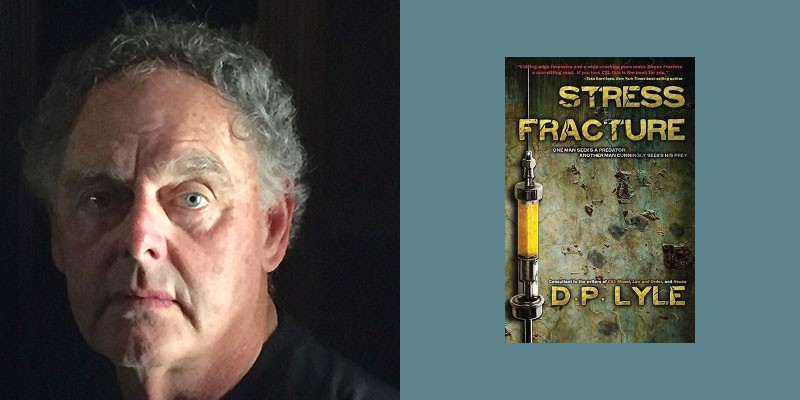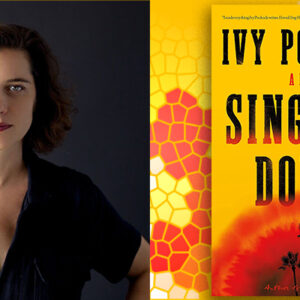Cardiologist Doug “D.P.” Lyle kept telling himself he would write a novel someday—someday when he finally retired. His biggest problem was he loved his career and had no plans to retire. Was this just an excuse not to write? He finally asked himself the age-old cliché: “If not now, when?” Now finally won out when he was about to turn 50 and “someday” became his second career.
He wrote. And wrote. For ten years he wrote, enduring 27 drafts. Finally, he completed his novel Stress Fracture. It was his first professionally published novel, although he’d self-published an earlier one. He’d also had several non-fiction books published on forensics topics for writers—he is a doctor, after all. (Poison, anyone?)
Lyle is a natural born storyteller from Huntsville, Alabama whose Scots-Irish storytelling chops seeped down through Appalachia. “Down there, if you can’t tell a story, they won’t feed you,” he says. “They just put you behind the barn.”
“Swapping lies,” is how he describes it.
“I had always wanted to write fiction simply because I had stories I wanted to tell but I was never sure I could.”
“I took some classes at the University of California-Irvine and then joined a couple of writing groups and wrote a lot. I also read dozens of books on writing and attended many writers’ conferences where I heard others speak on how they construct stories and write dialogue and create characters, and all the other components of good writing. So, I basically learned from books and from people and from there by simply sitting down and writing. The latter is probably the best teacher.”
He began writing at odd times, before going to the office or hospital, or in the evening. “I got the bug and couldn’t quit.” It took him two and a half years to complete his first novel, or so he thought. “I was learning.”
A year into his work, he befriended Bay Area book agent Kimberly Cameron at a San Diego State writers conference. “We hit it off and became friends long before we worked together.” When Stress Fracture was completed 18 months later, he sent all 138,000 words to her in a big box.
“I thought New York Times best seller list, here I come…She felt differently. ‘There’s a story in here somewhere,’ she said, ‘I just can’t find it.’”
She said she would read it again if he would rewrite and pare down. So, he did, and she rejected his second attempt. He rewrote it again and again. “I set it aside for two or three years and kept coming back to it.”
He changed the location, title, and protagonist. “The only thing that stayed the same was the bad guy and the real story plot.”
The fourth version—now titled Stress Fracture—he sent to Kimberley. It was down to 85,000 words. She called a week later. “I finally produced the book that met her standards.”
Even though it had morphed into a much more sophisticated version of his original attempt, “It all started with one story that I would not let go of. I think that’s a lesson.”
And, he learned, “It was a lot harder than I thought it was going to be. I just assumed, like everything else in life, if I wanted to do it, I could go do it…Some of it’s very naïve to think you can do anything you want to do…Those are lessons you learn. I assumed if you can tell a story, you can write a story. It’s a whole other kettle of fish…I don’t think it gets easier over time.”
In between novels, Lyle has used his medical knowledge to write non-fiction craft books for fiction writers eager to get their murders correct. He answers all types of questions about poison, gun shots, blunt force trauma, and more. His writing brought him to the attention of Hollywood, where he has consulted on numerous crime procedural shows and movies.
And yet, he always returns to his love of writing crime fiction. Writing a novel, he says, is like handling a critically ill patient in intensive care with numerous medical issues going on simultaneously. They’re referred to as “circling the drain” because the doctors could lose them at any moment, says Doug. “You have all of these things in the air and must weigh your choices because it will affect organs differently. Writing a novel is the same thing. They all mesh—all of the moving parts.
“You can’t mess up one of them—no bad dialogue, bad narration, bad plot, stupid characters. You must get all of these components working together smoothly. You can kill it so easily by ignoring one component. Scribbling out a scene? Most writers can do that in their sleep. But putting it all together is extremely hard.”
And just as important, Doug says, is plot sequence. Writers must understand when to release every tidbit of information at the proper time in their story. It sounds simple but realizing when the right moment is to add a certain piece of critical information to a crime novel keeps reader interested and the story moving. It’s difficult. “Novice writers,” he says, “put everything in the first chapter.”
“Ain’t no crying here,” he says. “Writing is blood sport.” It’s certainly not for the faint of heart.
So, if it’s so tough, why bother?
“I mean, what other job could you have where you can grab a cup of coffee and sit down and kill a couple of folks without even getting dressed?” he says. “And you get to play with so many cool imaginary friends.”
“I like sitting before the computer screen and making up stuff. And I think that is an important lesson for all writers—you must enjoy the process to be successful. If you don’t like sitting down and putting words on the page and constructing a story, then you should do something else because it will only be frustrating and maddening if you’re not having fun.”
“A lot of it was his perseverance…he just kept trying,” says Cameron. And that is the difference between those who get published and those who don’t.

___________________________________
Stress Fracture
___________________________________
Start to Finish: 10 years, two months
I wanted to be a writer: Age 40
Experience: Cardiologist
Writing Time: 10 years (27 rewrites)
Agents Contacted: One
Agent Responses: One
Agent Search: One Writer’s Conference
First Submission to Publisher: 2003
Time to Sell Novel: Two Months
First Novel Agent: Kimberley Cameron
First Novel Editor: Christy Philliippe
First Novel Publisher: Medallion Press
Inspiration: James Lee Burke, Elmore Leonard
Advice to Writers: Writing is an art and a craft. The first draft should be the art and the revisions the craft. Write fast. Edit slowly.
Website: www.DPLyleMD.com
Like this? Read the chapters on Lee Child, Michael Connelly, Tess Gerritsen, Steve Berry, David Morrell, Gayle Lynds, Scott Turow, Lawrence Block, Randy Wayne White, Walter Mosley, Tom Straw. Michael Koryta, Harlan Coben, Jenny Milchman, James Grady, David Corbett. Robert Dugoni, David Baldacci, Steven James, Laura Lippman, Karen Dionne, Jon Land, S.A. Cosby, Diana Gabaldon, and Tosca Lee.


















